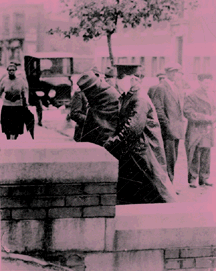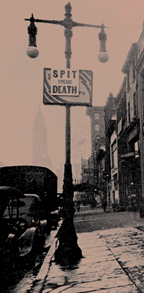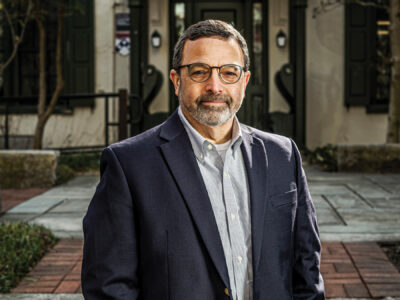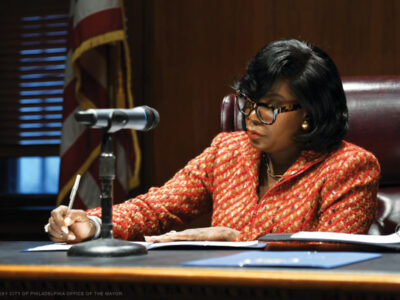
It started with a cough in the summer of 1918. In the next 120 days, nearly 22 million people around the world would die in one of the worst epidemics in modern times. And Philadelphia was to be the American city with the highest death toll.
By Eileen A. Lynch
It was the end of the summer in 1918 in Philadelphia, a city of a million and a half people.
World War I, “the war to end all wars,” was drawing to a close as the British crossed the Hindenburg Line. At the University of Pennsylvania, drilling, uniforms, and war courses were the order of the day for 2,240 students of draft age who had been inducted into the Students’ Army Training Corps (SATC), a federal program designed to prepare young men as officers. Penn’s dormitories and fraternity houses served as barracks. By order of Major Charles T. Griffith, the officer in charge of the program, the University’s daily newspaper, The Pennsylvanian, had been placed under military authority and served as the official bulletin of the SATC.
In Philadelphia, it was business as usual. People were flocking to the long-running British musical Chu Chin Chow at the Shubert Theater, Jerome Kern’s Leave It to Jane at the Chestnut Street Opera House, and John Philip Sousa’s Liberty Loan concert at Willow Grove Park. Everyone was sure it was just a matter of time until “the boys came home.” No one was paying much attention to the account of an unusual sickness reported earlier in the year by a Spanish wire service to Reuter’s London headquarters: “A strange form of disease of epidemic character has appeared in Madrid.”
Within a short time, eight million Spaniards were ill with what was to be named the “Spanish influenza.” Fueled by troop movements, it spread like wildfire across Europe, the Mideast, and Asia. By the summer of 1918, the “Spanish Lady” had reached American soil. In 120 days, more than half of the world’s population would fall victim to the influenza pandemic, and nearly 22 million would die of complications.
The disease began with a cough, then increasing pain behind the eyes and ears. Body temperature, heart rate, and respiration escalated rapidly. In the worst cases, pneumonia quickly followed. The two diseases inflamed and irritated the lungs until they filled with liquid, suffocating the patients and causing their bodies to turn a cyanotic blue-black.
In Pennsylvania, the influenza epidemic began almost unnoticed in the middle of September. First a few cases, and then the numbers began to rise rapidly. Worried state health authorities decided to add influenza to the list of reportable diseases. Their concern increased when 75,000 cases were reported statewide. The worst was still ahead.
Philadelphia was about to become the American city with the highest death toll in one of the three worst epidemics in recorded history.
Philadelphia newspapers and The Pennsylvanian chronicled the passage of the “Spanish Lady” day-by-day through city and campus.
Philadelphia, October 4: 636 new cases, 139 deaths.
Dr. A.A. Cairns, acting president of the Philadelphia Board of Health, is frantic: more new cases every day, and the city’s death toll is mounting. How can the disease be stopped when no one even knows why it is spreading? The state has already closed all the vaudeville and picture houses, theaters, and saloons in Pennsylvania. Cairns decides to close all schools and churches in the city…
Philadelphia businessmen are up in arms about the epidemic. More cases mean more employee absences and fewer customers. It is no longer business as usual, but business if possible. In desperation, the Bell Telephone Company runs the following full-page notice in the newspapers:
Telephone Service Faces A Crisis
The situation is one which the public must meet squarely — 800 operators — 27% of our force — are now absent due to the influenza. It is every person’s duty to the community to cut out every call that is not absolutely necessary that the essential needs of the government, doctors and nurses may be cared for.
Worried Philadelphians, wearing gauze influenza masks over their noses and mouths, quickly cross to the other side of the street if a passerby chances to cough or sneeze.
Weeping women in West Manayunk block the car of Dr. Joseph Schlotterer, who is making a house call, and permit him to leave only after he treats 57 neighborhood children.
Frantic shoppers strip pharmacy shelves bare. The press of customers is so great that the Philadelphia College of Pharmacy and Temple University suspend classes so that pharmacy students can help fill prescriptions. Most are for whiskey, which, now that saloons are closed, is available only in drugstores. Rather than wait to become a statistic, people turn to home remedies: goose-grease poultices, sulfur fumes, onion syrup, chloride of lime.
Snake-oil artists hawk their useless potions in newspaper ads:
Use Oil of Hyomei. Bathe your breathing organs with antiseptic balsam.
Munyon’s Paw Paw Pills for influenza insurance.
Sick with influenza? Use Ely’s Cream Balm. No more snuffling. No struggling for breath.
To prevent further spread of the epidemic among Penn students, most of whom are in the SATC, the Board of Health cancels a football rally and a campus Liberty Loan rally featuring screen actor William S. Hart.
Major Griffith, in charge of the SATC at Penn, warns that campus residents who fail to keep their windows open will be severely punished. The Hospital of the University of Pennsylvania is quarantined, and no visitors are permitted.
The SATC commandeers two of the University’s largest fraternity houses — Delta Psi and Phi Kappa Psi — and fits them out as emergency hospitals. Due to the shortage of physicians, third- and fourth-year Penn medical students volunteer to take care of the patients.
Panic is beginning the grip the city.

Philadelphia, October 6: 788 new cases, 171 deaths.
The Philadelphia Inquirer derides the closing of public places:
What are the authorities trying to do? Scare everyone to death? What is to be gained by shutting up well-ventilated churches and theaters and letting people press into trolley cars?
What then should a man do to prevent panic and fear? Live a clean life. Do not even discuss influenza… Worry is useless. Talk of cheerful things instead of disease.
The Inquirer heeds its own admonitions and relegates all further news of the epidemic to its back pages. In the other city newspapers, the flu is still page-one news.
The war continues in Europe. General Pershing’s forces advance three miles but, across the Atlantic, the epidemic is stalling the homefront war effort. To boost the case for the Fourth Liberty Bond Loan, the EveningBulletin prints an anonymous article that claims the Spanish influenza began in the German trenches. Whether an artful propaganda piece or mere speculation, the report stirs bitter feelings against the “beastly Huns.” The sale of Liberty Bonds skyrockets.
At Penn, the Board of Health puts the Houston Hall poolroom under indefinite quarantine and fumigates all dormitories. The Christian Association calls for student volunteers to help in the current emergency.
Philadelphia, October 8: 1,481 new cases, 250 deaths.
The shortage of doctors and nurses, 75 percent of whom had been called to military duty, is acute. The director of the Philadelphia Hospital pleads for volunteers to relieve nurses who have collapsed from overwork.
In many families, both parents are ill and unable to care for their children. Their cries for help often go unheeded, as many neighbors fear entering a house where there is influenza. Others, without thought of their own safety, tend the ill, care for the children, and comfort the dying. Roman Catholic Archbishop Dennis Dougherty gives permission to 1,000 Sisters of Saint Joseph to work in private residences caring for the sick.
Philadelphia, October 10: 5,531 new cases, 361 deaths.
Philadelphia hospitals are filled to overflowing. Hospital beds are set up in the Armory. The Medico-Chirurgical Hospital, closed to make room for the construction of the new Benjamin Franklin Parkway, is reopened. The University of Pennsylvania, together with Jefferson College and Hahnemann Medical College, recruits 300 fourth-year medical students to aid overworked physicians.
Isaac Starr, M’20, is assigned to the Medico-Chirurgical Hospital. With only a single lecture about influenza to guide him, he finds there is little he can do, other than get the dead out of the way for the living. He never sees the faces of his fellow workers. They are gowned and masked like himself.
The Philadelphia Public Ledger uses the epidemic as a stick in its long-running battle with State Senator Edwin H. Vare and his political machine. A front-page article claims that Vare holds the street-cleaning contracts for South Philadelphia, where mortality is heaviest. Besieged by outraged residents, the Bureau of Street Cleaning agrees to sprinkle the streets with disinfectant.
Red Cross volunteers meet to make influenza masks and sew shrouds for the mounting numbers of dead. The daily death notices fill an entire page: seven columns of small print with a repetitious litany: “…of pneumonia, age 21” “…of influenza, age 26.” The toll is heaviest among young adults.Philadelphia, October 11: 4,013 new cases, 517 deaths.Local businessmen voluntarily close their shops and distribute food and supplies to suffering families. One department store — Lit Brothers — donates two delivery trucks to serve as ambulances. Another — Strawbridge and Clothier — uses its telephone-order line to field calls for help: Call Filbert 100. If the response is ‘Strawbridge and Clothier,’ ask for ‘Influenza.’
Penn students join with off-duty policemen to relieve the shortage of hospital stretcher-bearers, carrying in the living only to exchange them for the dead. Other Penn student-volunteers at the University Settlement House help in the dispensary and operate a soup kitchen for children whose parents are too ill to feed them.
After 12 Penn dental students are stricken, the University closes the Dental School, noting that “working over patients’ mouths subjects the men to the danger of contracting the disease.”
Philadelphia, October 14: 4,302 new cases, 557 deaths.
A new health menace threatens: the dead are not being buried fast enough.
More than 500 corpses are awaiting burial, some for more than a week. The Office of the Coroner cannot keep up with the demand for death certificates. Cold-storage plants are used as temporary morgues, and the J.G. Brill Company, manufacturers of trolley cars, donates 200 packing crates to be used as coffins. Prisoners from the House of Correction team up with seminarians from St. Charles Seminary to dig graves, as the cemeteries cannot keep up with the demand.
To deal with the problem of hundreds of unburied corpses, volunteers drive horse-drawn carts through the city streets, calling people to bring out the dead. Wagonloads of bodies, each tagged for identification, are buried at Potter’s Field at Second and Luzerne Streets, where the Bureau of Highways is digging trenches for graves. Only the promise that bodies can be reinterred when the epidemic abates persuades grieving relatives to give up their loved ones to the “dead wagons.”
Fifty students from Penn’s Dental School volunteer to work in city hospitals to relieve exhausted medical staffs. The Board of Health bans all public meetings on campus and shuts down the pool. University officials receive word that Arthur T. Eissing, W’18, class president, has died of pneumonia at Camp Dick, Texas, after contracting influenza while in Philadelphia.
Philadelphia, October 16: 2,280 new cases, 650 deaths.
The heavy death toll attracts human vultures. Some cemeteries raise burial fees to $15 and tell families they will have to dig the graves themselves. Several undertakers increase the price of their services by 500 percent.
Unscrupulous pharmacists inflate the price of cheap whiskey — usually the only treatment prescribed for influenza — to $52 a gallon. Enterprising barkeeps defy the Board of Health ban on saloons with back-door sales. One saloon owner argues with the Vice Squad that he is only looking after the health of his regular customers.
The ferries are jammed with people anxious to get to Camden, where the bars are still open. The daily mass exodus causes Dr. Henry Davis, chief of the Camden Board of Health, to close the city’s saloons “in the interest of public health. Thousands of the lowest people of Philadelphia came over the river and created great disorder. They were the vilest men and women that have visited Camden.”
At Penn,the Wharton Evening School of Finance and Accounting finally opens after several postponements. Photo sessions for new students in the College and the Towne Scientific School are canceled due to illness of the photographers. K.B. Crawford, a senior medical student who contracted the flu while working at the Emergency Red Cross Hospital, dies of complications from the disease.
Philadelphia, October 17: 1,686 new cases, 711 deaths.
The city’s hospitals are placed under police supervision,
with patrol cars serving as ambulances. The Red Cross Home Service, besieged
by servicemen overseas for information about their families, frequently
sends no reply. The families do not wish them to know their loved ones
have died.
Countless deeds of charity help rescue the forgotten
members of society — the destitute, the orphaned, the retarded, and the
friendless. Sisters of the Holy Child comfort and care for youngsters
in a West Philadelphia home for “backward children” after all
the staff have fled. Emergency Aid members visit shabby boarding houses
where hundreds lie ill with no one to assist them and arrange for their
care.
A man who sneezed is forcibly ejected from a trolley
by his fellow passengers.
Little girls jump rope to a grim new rhyme:
I had a little bird
And its name was Enza
I opened the door
And in-flew-Enza.
At Penn, football games with Swarthmore and the Marines
are canceled. The Christian Association issues an urgent call for more
student volunteers.
Philadelphia, October 20: 1,334 new cases, 606 deaths.
Philadelphians note the latest count in reported
cases. Is the epidemic waning?
Dr. Franklin Royer, acting Pennsylvania Commissioner
of Health, says no:”For a five-year period, the state’s daily
average death rate in October from influenza,la grippe, and pneumonia
combined is less than 30. Yet Philadelphia continues to report hundreds
of deaths daily.”
Dr. J. Solis-Cohen says yes: “The progress of the
influenza epidemic should be noted from the number of new cases and not
from the number of deaths.”
Dr. Solis-Cohen is right.
As quickly as the epidemic had come, it left.
Churches reopened on October 27 in Philadelphia. Schools,
theaters, vaudeville houses, and bars followed in quick succession.
Penn’s Dental School reopened. Delta Psi house and Phi
Kappa Psi house, used as emergency hospitals, became a barracks and a
naval officers’ mess hall, respectively. Penn student volunteers returned
to their studies.
The passage of the “Spanish Lady” through
the streets of Philadelphia left in its wake 12,191 reported deaths and
47,094 reported cases in four weeks and a business community crippled
by revenue-losses in the millions. Among Penn’s 5,000 students, there
had been four deaths and 312 cases reported.
World War I killed 15 million people in four years;
the Spanish flu killed perhaps twice that number worldwide in six months.
It killed more Americans than all combat deaths of this century combined.
No other disease has killed so many so fast. Yet the collective amnesia
regarding the pandemic is astonishing. Today most Americans know more
about the Black Death of medieval times than they do about the 1918 flu.
One question still haunts medical science: Where did
the virus come from and where did it go after 1918? Some believe that
a mild hog flu virus combined with an equally mild Pfeiffer bacillus in
a synergetic process, producing a killer that injured human lungs beyond
their capacity to recover — but no one knows for certain.
Eileen A. Lynch is a writer and editor. She was formerly a research specialist in epidemiology at Penn and later a senior writer in Development Communications. This account is based primarily on contemporary newspaper accounts of the epidemic’s progress in the city and on the Penn campus.





Patient zero for the [so-called] Spanish Flu was a recently jabbed soldier in Fort Riley Kansas USA! [Fact!] Renaming it was fraudulent!